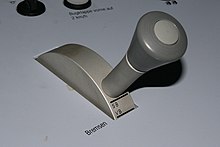Driver's brake valve
- Machine translation, like DeepL or Google Translate, is a useful starting point for translations, but translators must revise errors as necessary and confirm that the translation is accurate, rather than simply copy-pasting machine-translated text into the English Wikipedia.
- Consider adding a topic to this template: there are already 1,897 articles in the main category, and specifying
|topic=will aid in categorization. - Do not translate text that appears unreliable or low-quality. If possible, verify the text with references provided in the foreign-language article.
- You must provide copyright attribution in the edit summary accompanying your translation by providing an interlanguage link to the source of your translation. A model attribution edit summary is
Content in this edit is translated from the existing German Wikipedia article at [[:de:Führerbremsventil]]; see its history for attribution. - You may also add the template
{{Translated|de|Führerbremsventil}}to the talk page. - For more guidance, see Wikipedia:Translation.


The driver's brake valve is a complicated valve system for controlling the compressed air brake of a railway vehicle.[1] Depending on its setting, it controls whether the brake pipes of a compressed air brake are evacuated and thus whether braking is applied or maintained; or if the brake pipes are connected to a compressed air reservoir, it controls whether the brakes are released again or remain released.
This equipment is found on the footplate of locomotives or in the driver's cab of power cars and driving cars in multiple unit's, hence the name.
In the simplest case the position of the lever controls the extent to which the valve opens, how quickly compressed air can be released from the pipes or the reservoir in the braking system.
The setting of modern driver's brake valves controls the dynamic reduction of the remaining pressure in the brake pipes.
References
- ^ "Die Bremsenbude - Allgemeines über die Führerbremsventile".
External links
- "Die Bremsenbude - Allgemeines über die Führerbremsventile".










